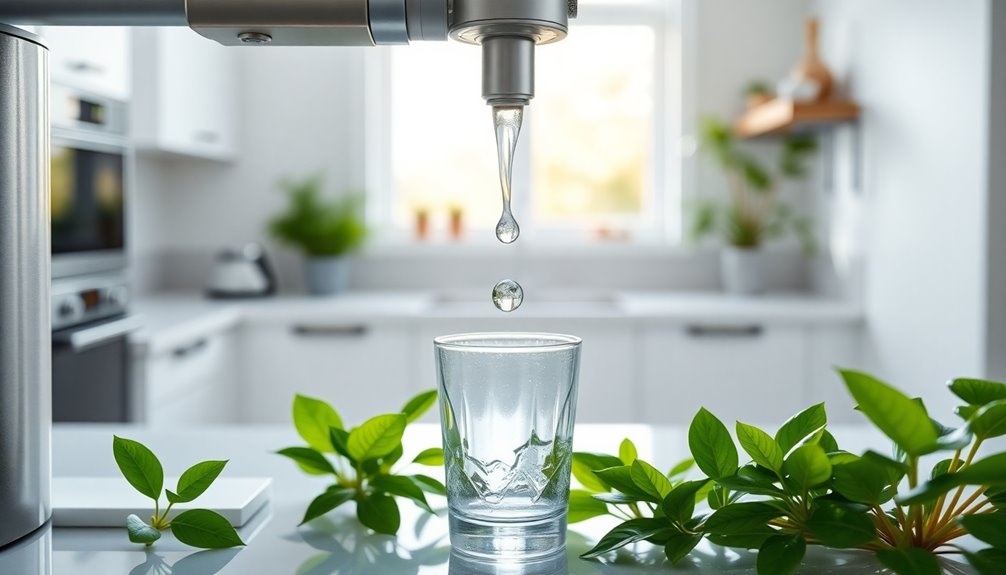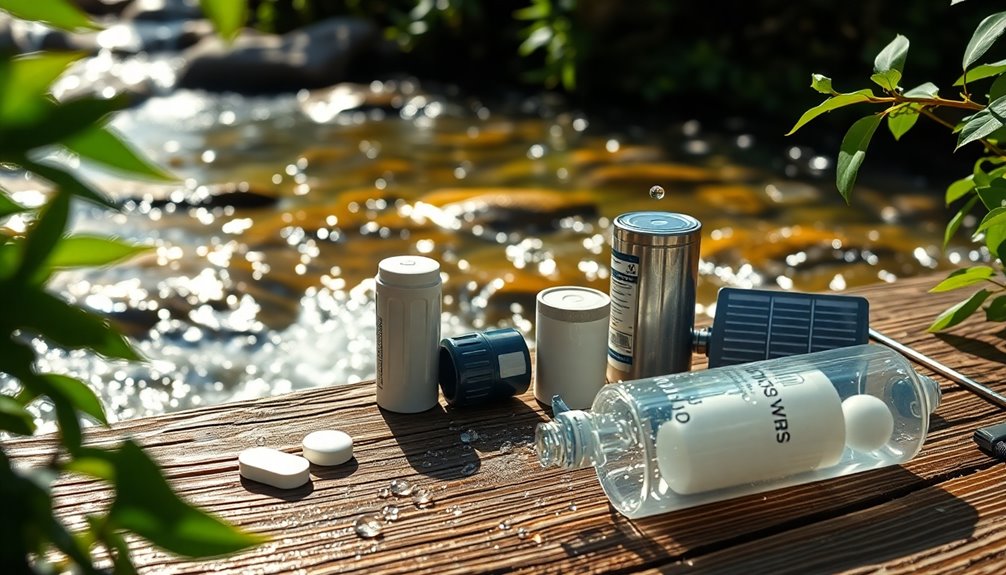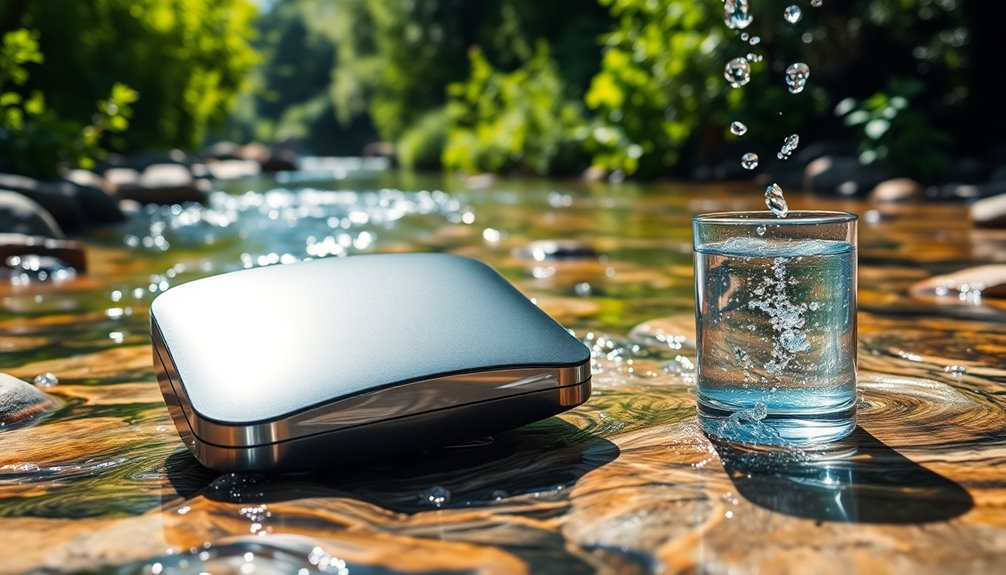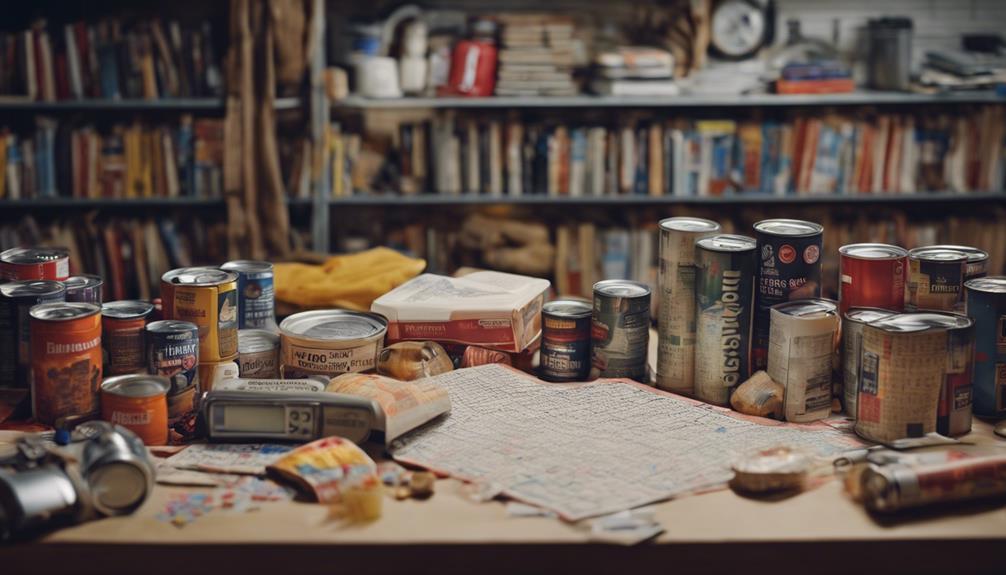Purifying water is essential to protect yourself against harmful contaminants and waterborne diseases. You can guarantee safe drinking water wherever you are by using methods like boiling, which kills harmful microorganisms, and filtration to remove chemicals and sediments. Reverse osmosis offers thorough purification, eliminating both heavy metals and dissolved solids. Alternatively, UV purification efficiently disinfects while maintaining the water's natural taste. Evaluate your situation to choose the right method, considering factors like contamination type and available resources. Understanding these options can empower you to keep your water safe and healthy, opening up a wider world of purification techniques.
Key Takeaways
- Boiling water for at least one minute effectively kills microorganisms but does not remove chemical contaminants like heavy metals.
- Reverse osmosis filtration eliminates up to 99% of dissolved solids and heavy metals, providing thorough purification for safe drinking water.
- Activated carbon filtration improves taste and removes chlorine and VOCs, but is ineffective against heavy metals and microorganisms.
- UV purification is a chemical-free method that eliminates 99.9% of harmful microorganisms while preserving essential minerals in water.
- Regular maintenance and inspections of purification systems ensure optimal performance and consistent access to safe drinking water.
Importance of Water Purification

Why is water purification essential for our health and environment? You might not realize it, but clean water is critical in preventing the spread of waterborne diseases like cholera and typhoid fever. By removing harmful contaminants such as bacteria, viruses, and chemicals, water purification protects you and your community from serious illnesses. It also saves you money in the long run by reducing medical expenses and time off work due to sickness.
Beyond health, purified water plays a significant role in environmental protection. It safeguards aquatic ecosystems by filtering out pollutants before wastewater is released, preserving our natural water sources for generations to come. Effective removal of harmful substances ensures that communities have access to safe drinking water, which is vital for public health. By ensuring clean water is available, you also promote sustainable economic growth and protect aquatic life from toxic substances.
Moreover, access to clean water boosts food safety and agricultural output, which supports local economies. Water purification improves your quality of life by enhancing the taste and odor of water and promoting skin health. Ultimately, prioritizing water purification isn't just about immediate health benefits; it's a crucial step towards creating a healthier, more sustainable future for you and your community.
Common Water Contaminants

When it comes to water quality, understanding common contaminants is essential for your health. You might encounter physical, chemical, and biological pollutants that can negatively impact both your well-being and the environment. Let's explore the types of contaminants, their potential health effects, and how you can detect them. Effective waste disposal practices are crucial in minimizing the impact of physical contaminants such as sediments and plastics on aquatic ecosystems.
Types of Water Contaminants
Water contamination is a pressing issue that affects the quality and safety of our drinking water. Understanding the types of water contaminants is essential for ensuring your health and well-being.
Physical contaminants include sediments, dust, and organic materials, often stirred up by storms, erosion, or human activities like construction. These can affect the appearance of water and indicate larger environmental issues. Chemical contaminants, such as pesticides, heavy metals, and toxic chemicals, often find their way into water sources through agricultural runoff or industrial waste. These substances pose significant risks to both human health and aquatic ecosystems, with heavy metals being particularly notorious for their long-term health effects. Biological contaminants, including bacteria, viruses, and harmful microorganisms, can also infiltrate water bodies, often due to untreated sewage or animal waste. Addressing these contaminants requires a multifaceted approach, including better filtration technologies, stricter regulations, and increased public awareness. Similarly, practices such as learning poisonous plant identification tips can help communities avoid exposure to harmful natural toxins and recognize signs of ecological imbalance in their environment.
Biological contaminants include bacteria, viruses, parasites, and algae, all of which can lead to serious health problems if ingested. These pathogens can enter water systems through human or animal waste, highlighting the importance of water treatment. Finally, radiological contaminants like uranium and radon can seep into water supplies, especially in areas near nuclear activities or natural deposits.
Health Effects of Contaminants
Understanding the health effects of common water contaminants is essential for maintaining your well-being. Exposure to these harmful substances can lead to serious health issues, and it's vital to be informed. Here are four key contaminants to watch out for:
- Arsenic: Long-term exposure can increase your risk of various cancers, skin diseases, and even developmental issues in children. It poses a risk comparable to tobacco smoke.
- Disinfection Byproducts (DBPs): Formed when chlorine interacts with organic materials, DBPs are linked to bladder and rectal cancer. They may also contribute to birth defects, especially if exposure is significant during bathing or showering. Poor water quality is a major factor in the prevalence of these harmful byproducts.
- Nitrate: Common in agricultural areas, high nitrate levels can lead to serious health problems like cancer and "blue baby syndrome" in infants. This risk grows when combined with a high meat diet.
- Lead and Other Chemicals: Lead exposure can harm children's development and lead to cardiovascular issues in adults. Pesticides and PFAS are linked to various health problems, including cancer and immune system damage.
Stay informed and proactive about the quality of your drinking water to protect your health.
Detection Methods and Tools
In today's world, detecting water contaminants is essential for ensuring safe drinking water. You can utilize various methods and tools to identify both chemical and biological pollutants effectively. For heavy metals like lead and mercury, advanced graphene-based sensors are tailored for precise detection. Traditional methods like ICP and UV-VIS spectrophotometers work well in labs, but they aren't ideal for on-site testing.
When it comes to bacterial contamination, consider using DNA-magnetic particle technology. This allows for rapid detection of specific bacteria, saving you time compared to traditional methods that require days of incubation. Microfluidic devices can also help identify harmful bacteria like *E. coli* and *Salmonella* with ease. Moreover, water security is a growing concern, as over 2 billion people live in water-deficient countries, highlighting the necessity for effective detection methods.
For nutrients and organic pollutants, microfluidic devices equipped with optical methods, such as Raman spectroscopy, are invaluable. These can detect changes in nutrient levels efficiently. Advanced sensors like smartphone adapter chips allow you to conduct optical detection at a lower cost, making safety accessible.
Boiling Water for Purification

Boiling is one of the simplest and most effective methods for purifying water, especially in emergency situations or during outdoor adventures. It's a straightforward process that you can do with minimal equipment, making it easily accessible when you need it the most. Here are some key points to remember:
- Kills Microorganisms: Boiling effectively eliminates bacteria, viruses, and protozoa.
- Quick Process: At sea level, boiling water for at least one minute guarantees it's safe to drink.
- Altitude Considerations: If you're at higher altitudes, extend the boiling time for effectiveness.
- Removes Chlorine: Boiling for about 15 minutes can help evaporate chlorine.
Additionally, boiling is particularly useful in emergencies because it kills harmful pathogens effectively without the need for specialized equipment.
However, keep in mind that boiling doesn't remove chemical pollutants like lead or arsenic, nor does it eliminate heavy metals or pesticides. While it's a reliable method, it can also affect water taste and quality by driving out dissolved gases. Plus, boiling consumes energy and time, particularly for larger volumes. So, while boiling is a great short-term solution, consider filtration systems for long-term water purification needs.
Understanding Distillation

Distillation is a highly effective method for purifying water, transforming it into a safe and clean resource. You start by adding water to a boiling chamber and heating it until it reaches its boiling point. Once the water evaporates into steam, it rises into a cooling system. As the steam passes through a condenser, it cools down and condenses back into liquid form. This condensed water then drips into a clean container, effectively separating it from contaminants.
Through this process, distillation removes a variety of harmful elements including chemicals like chlorine, heavy metals such as lead, and microorganisms including bacteria and viruses. You can rely on a water distiller to produce water that's over 99.9% free of contaminants. Plus, there's no installation required; these units come pre-installed and are easy to use. Moreover, a water distiller is designed to remove a wide range of contaminants, ensuring that the water you consume is as pure as possible.
While distillation is reliable, it does have some limitations. It may not effectively remove all organic compounds, and the process can take several hours to produce just one gallon of water. However, with regular maintenance, a distiller can provide you with consistent, purified drinking water.
Filtration Methods Explained

When it comes to filtering water, you'll find various types of filters, each designed for specific needs. Understanding their maintenance requirements is just as essential, as proper care guarantees effective purification. Let's explore how different filtration methods work and what it takes to keep them running smoothly. Additionally, effective filtration eliminates large compounds and small contaminants causing diseases, ensuring healthier drinking water.
Types of Filters
There are several effective filtration methods you can use to purify water, each designed to target specific contaminants. Here's a quick overview of four popular types:
- Mechanical and Sediment Filtration: This method employs a mesh barrier or porous material to filter out particles like rust, sand, and silt. It improves water clarity but doesn't remove chemicals or microorganisms. Sediment filtration is essential for protecting downstream filters from damage.
- Activated Carbon and Absorption Filtration: Utilizing activated carbon, this filter effectively removes chlorine, VOCs, and some pesticides, enhancing water taste and odor. It's often the first stage in multi-stage systems.
- Reverse Osmosis (RO) and Ion Exchange Filtration: RO systems use a semipermeable membrane to eliminate dissolved solids and heavy metals. Ion exchange filters soften hard water but don't filter out bacteria or VOCs.
- Ultraviolet (UV) and Advanced Filtration: UV disinfection kills harmful microorganisms using ultraviolet light, while ultrafiltration targets microscopic contaminants. These methods are often used alongside other filtration systems for best results.
Maintenance Requirements
Understanding the types of filters available is just the beginning; maintaining them is key to guaranteeing your water stays clean and safe. Regular maintenance schedules are essential. For instance, replace sediment filters every 3-12 months, and activated carbon filters every 6-12 months. Reverse osmosis membranes typically need replacement every 2-3 years, while UV lamps should be replaced annually.
Don't overlook cleaning and sanitization either. For reverse osmosis systems, chemical cleaning is recommended every one to two years. You should also clean filter housings with mild soap and warm water and verify the UV lamp housing is cleaned every three to six months.
Regular inspections matter too. Perform daily checks for leaks or wear, and conduct monthly thorough inspections of the entire system. Testing water quality regularly for pH, turbidity, and contaminants guarantees peak performance. Additionally, regular inspection helps identify issues early, allowing for timely resolutions before they escalate.
Lastly, be proactive. Replace wear-prone components like seals and gaskets on schedule, calibrate system parameters, and test backup batteries. By following these maintenance requirements, you'll keep your water treatment system running smoothly and guarantee a safe drinking supply.
Reverse Osmosis Insights

Reverse osmosis (RO) offers a powerful solution for purifying water by effectively removing a wide range of contaminants. This process utilizes a semi-permeable membrane, applying pressure to push water from a high concentration of contaminants to a low concentration, reversing natural osmosis. Here are four key benefits of RO systems:
- Comprehensive Contaminant Removal: RO systems can eliminate up to 99% of dissolved solids, including heavy metals, microorganisms, and volatile organic compounds. Additionally, RO systems are known to remove dissolved salts, ensuring that harmful substances like sodium and chloride are filtered out.
- Improved Taste and Odor: By removing chlorine, VOCs, and other unpleasant chemicals, your drinking water will taste fresher and cleaner.
- Environmentally Friendly: RO systems reduce reliance on bottled water, promoting sustainability and reducing plastic waste.
- Easy Maintenance: With proper care, RO systems are simple to install and maintain, providing long-term benefits.
The RO process involves multiple filters, including sediment and carbon filters, followed by the RO membrane, which guarantees nearly all contaminants are filtered out. Plus, a post-carbon filter polishes the water, enhancing your drinking experience. By investing in an RO system, you'll enjoy safe, great-tasting water right at home.
Chlorination Process Overview

Chlorination plays an essential role in guaranteeing water safety by effectively neutralizing harmful microorganisms. You can choose from several methods of chlorination, depending on the water quality and treatment needs. If the water is clear, plain chlorination is often sufficient, as it disinfects without needing pre-treatment. For raw water that requires additional treatment, pre-chlorination enhances coagulation and helps eliminate undesirable tastes and odors.
Once you've completed the treatment stages, post-chlorination guarantees a residual disinfectant remains in the distribution system. It requires a precise dosage, typically between 0.25 to 5.0 mg/L, to maintain safe chlorine levels. In cases of heavy contamination, specialized methods like double or multiple chlorinations can be effective. Furthermore, using multiple chlorination methods may be necessary in industries that demand higher water quality standards.
You can add chlorine in various forms, such as gas, sodium hypochlorite, or even through on-site generation. Understanding the chemical reactions involved is vital, as they produce hypochlorous acid, an effective disinfectant. However, keep in mind that reactions with organic compounds can create by-products. Adapting these chlorination methods to your specific water treatment needs guarantees safe drinking water for everyone.
Benefits of UV Purification

Often regarded as a cutting-edge solution, UV purification offers numerous advantages for guaranteeing safe drinking water. This method effectively eliminates 99.9% to 99.99% of harmful microorganisms, including bacteria, viruses, and parasites, making it a reliable choice for safe hydration. Here are some key benefits:
- Chemical-Free and Environmentally Friendly: UV purification uses no chemicals, preserving water's taste and odor while eliminating harmful byproducts. Additionally, this process is chemical-free, ensuring that essential minerals in the water are retained.
- Low Maintenance and Efficiency: With minimal upkeep, you'll only need to replace the UV lamp annually, and the fast treatment process requires no holding tank.
- Versatility: This method works with various water sources, such as well water or rainwater, guaranteeing safety in diverse situations, including emergencies.
- Safety: It effectively inactivates pathogens, including chlorine-resistant ones like Giardia, and guarantees your water supply remains consistently safe, 24/7.
Choosing the Right Method

Selecting the right water purification method can feel overwhelming, given the variety of options available. You need to evaluate your specific needs, budget, and water quality. For instance, if you're looking for an affordable and user-friendly solution, activated carbon filtration could be your best bet. It enhances water's taste and odor while effectively removing chlorine and many chemicals. However, it won't handle heavy metals or total dissolved solids. It's important to note that activated carbon filters are suitable for residential and small-scale use, making them a practical choice for many households. Additionally, improving indoor air quality can be a crucial consideration when selecting purification methods, as some systems may also contribute to a healthier home environment.
If you're after thorough purification, reverse osmosis is highly effective. It removes nearly all pollutants, including bacteria and heavy metals, but be mindful of its higher cost and the water it wastes during filtration.
Distillation is another option that eliminates heavy metals and bacteria, but it's slow and energy-intensive. Plus, it won't remove contaminants with boiling points lower than 100°C.
Lastly, evaluate UV and infrared filtration if you want to target microbes and soften water. UV is energy-efficient but requires electricity, while infrared won't completely purify your water.
Ultimately, weigh the pros and cons of each method against your needs to make the best choice for safe drinking water.
Frequently Asked Questions
How Can I Tell if My Water Is Contaminated?
You can tell if your water's contaminated by looking for visual indicators like discoloration, cloudiness, or floating debris. Pay attention to any unpleasant odors, such as a rotten-egg smell or metallic taste. Check for signs of biological pollution, like dead fish or algae blooms. If you notice low water pressure or stains in your sink, that might signal issues. Finally, keep an eye on government advisories for any warnings about water safety.
Is It Safe to Mix Purification Methods?
Is it really safe to mix purification methods? The answer isn't straightforward. Combining techniques can boost water purity, but you've got to be careful. Some combinations work wonders, like using filtration before UV treatment to enhance effectiveness. But others can create harmful by-products. Always consider compatibility and health implications. To be safe, test your water regularly and guarantee your methods meet health standards. You want the safest water possible, after all!
How Often Should I Replace Filters?
You should replace your water filters every 6 to 12 months, depending on usage and type. If you have high water demand, consider changing them every 3 to 6 months. Keep an eye out for signs like poor taste, decreased flow, or visible sediment. Regularly inspect the filter and follow your manufacturer's guidelines to guarantee peak performance. Monitoring your filter's condition will help you determine the best replacement schedule for your needs.
Can I Purify Water Using Sunlight?
Yes, you can purify water using sunlight! One effective method is Solar Water Disinfection (SODIS), where you fill clear bottles with clean water and expose them to direct sunlight for at least six hours. This process leverages UV light to kill harmful microorganisms. Additionally, innovative sunlight-activated powders can disinfect water in just 60 seconds. By using these methods, you can guarantee your water is safe to drink, even in challenging conditions.
What Are the Costs Associated With Each Purification Method?
Did you know that bottled water can cost you over $500 a year? When considering water purification methods, Reverse Osmosis systems range from $1,000 to $4,000, while well water systems can hit $5,000. Activated carbon filters are more affordable at $300 to $900. U/V light systems fall between $500 and $1,500. Ultimately, the initial investment might be higher, but you'll save money in the long run compared to buying bottled water.
Conclusion
In your quest for safe drinking water, remember that every method has its strengths. Whether you boil, filter, distill, or chlorinate, you can guarantee purity. Whether you choose reverse osmosis for thoroughness or UV purification for speed, you're making an essential choice for your health. Whether you're camping in the wild or just filling your glass at home, knowing how to purify water means you're empowered, informed, and ready to enjoy clean, safe hydration anytime, anywhere.










